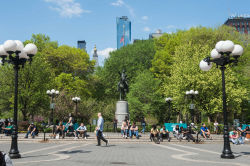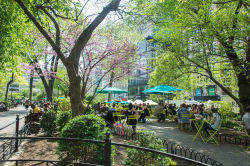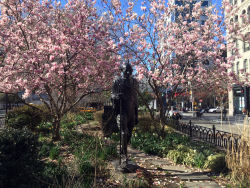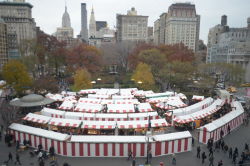Union Square Park
The Daily Plant : Wednesday, April 11, 2001
PARKS RECLAIMS MANHATTAN WATERFRONT PROPERTY
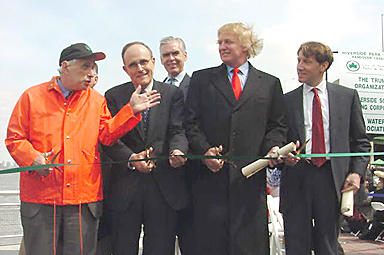
Photo by Malcolm (Cinema) Pinckney
One century ago, railroad tracks traced the western shoreline of Manhattan. Today it is a bikepath that links the island tip to tip. With the help of Mayor's Office, Parks, the Planning Commissioner, Donald (Tower) Trump, and six key civic organizations, a view of Manhattan's great natural resource, the Hudson River, has been reclaimed for park users. Where once there were boxcars and gantry ramps, today there are trees, too. In a ceremony on Tuesday, April 10, 2001 New Yorkers celebrated seven new acres, the first of more than twenty to be developed as parkland. This addition will be the largest new greensward along the west side of Manhattan, and will open the possibility for New Yorkers to walk, skate, and bicycle along the Hudson's edge for eleven uninterrupted miles from Battery Park to Fort Washington Park.
Riverside Park South, designed by Thomas Balsley Associates and funded by Hudson Waterfront Associates, retains the industrial flavor of the railroad yard once situated on its grounds. Angular paths, formed from the old concrete relieving platforms, evoke the railroad tracks. Abandoned ramps and piers, as well as a rusting gantry, are iconic reminders of times and technologies past. The park's design includes athletic facilities as well as areas for quiet reflection. Three basketball courts, two handball courts, and a three-quarter-size soccer field invite athletes to hone their skills. A promontory, esplanade, and winding walkway welcome visitors who wish to enjoy nature and experience river breezes. Built atop the remains of the original wooden shipping Pier I, is a 715-foot long recreational pier. Visitors to the pier will be surrounded by the river almost completely, experiencing a view of Manhattan once reserved for sailors.
The site of Riverside Park South is rich with history. In October 1851, the first Hudson River Railroad roared up the Hudson River shoreline, carrying passengers as far north as Rensselaer, New York. When Cornelius Vanderbilt merged the New York Central and Hudson River Railroads in 1869, the land was acquired to serve as the New York Central Railroad yard. It was the primary departure, receiving, and classification area for the only all-freight line on the island of Manhattan. Almost a century later, in 1968, the New York Central Railroad merged with the Pennsylvania Railroad; two years later the new Penn Central Railroad declared bankruptcy, and the railyard was closed. For decades thereafter, developers eyed the 56-acre tract.
In 1984, Donald Trump bought the rights to the property. Economic conditions as well as opposition by community groups and elected officials halted his first two proposals. A breakthrough occurred when six non-profit civic groups-the Regional Plan Association, the Municipal Art Society, The Natural Resources Defense Council, the Parks Council, Riverside Park Fund, and Westpride-collaborated with the developer, elected officials, and City agencies to design an alternative plan, the basis of what the park looks like today. This proposal reduced the size of the development, moved the elevated highway under a new Riverside Boulevard, and created a dramatic sweep of waterfront park.
Riverside South was approved by New York City on the condition that the developer, Hudson Waterfront Associates, pay for the creation of a 21.5-acre park, and fund its maintenance in perpetuity. Sixteen buildings will be built, the park along the Hudson extended to 59th Street and deeded to the City of New York for parkland. In response to concerns by elected officials, plans to relocate the elevated highway were delayed. Currently, the elevated highway overshadows the benches and seashore grasses. Riverside South Planning Corporation, the coalition of civic organizations, is working to complete the original plan.
Having helped conceive of this park, community members will bring it to life with their participation. An art and programming coordinator will design afterschool activities for children and weekend activities for families that reflect local interests and take full advantage of the striking recreational opportunities the Hudson offers. Young people will have the chance to learn fishing and kayaking, and to study the diverse natural life that inhabits the estuary. The paved strip that runs below the highway is available for walkers and bikers, even jugglers and unicyclists.
Thanks to all the Parkies who facilitated the acquisition and development of Riverside South.
THIRTEEN YEARS AGO IN THE PLANT
(Wednesday, April 20, 1988)
PARKS ARBOR DAY EVENTS SPROUTING AROUND TOWN
On Friday, April 29, New York State will observe its 100th Arbor Day; and Parks will plant, prune and hug-yes hug-the city's trees.
At 11:30 a.m. on the 29th the Indian Consulate will launch Arbor Day celebrations with music and mango juice near the Gandhi statue in Union Square Park in Manhattan. A "Chipko Day" ceremony, led by Mayor Koch, Commissioner Stern and representatives from the Indian Consulate will start at noon. In Hindi and other Indian dialects, "chipko" means "to hug."
QUOTATION FOR THE DAY
"I've known rivers:
I've known rivers ancient as the world older
than the flow of human blood in human veins.
My soul has grown deep like the rivers."
Langston Hughes (1902-1967)
Check out your park's Vital Signs
Clean & Safe
Green & Resilient
Empowered & Engaged Users
Share your feedback or learn more about how this park is part of a
Vital Park System

